 |
||||||||||||||||||||||||
 |
 |
|||||||||||||||||||||||
 |
||||||||||||||||||||||||
 |
 |
 |
 |
|||||||||||||||||||||
| 2015 CIRCLES | 2014 CIRCLES | 2013 CIRCLES | 2012 CIRCLES | |||||||||||||||||||||
|
||||||||||||||||||||||||
 |
 |
|||||||||||||||||||||||

|
Ground Report – Sompting (2), West Sussex, 18/07/05Our third formation during this slow Sussex season appeared a few fields to the south of the four armed ‘spinner’ of last year. The location of this crop circle is particularly serene, despite its fairly close proximity to the busy A27. From the field only one road can be seen, and this only when a vehicle drives past. The formation itself lies at the top of the field, in which the tramlines flow gently downhill to the south. 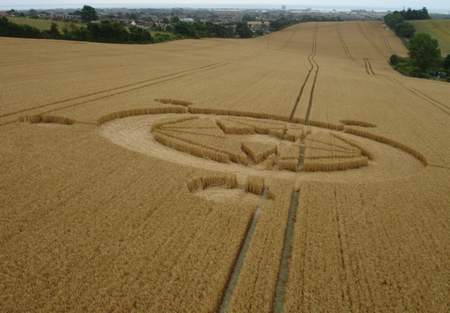
This design appears to be the most complex in Sussex this season. A pentagram in the centre in which only the ‘construction’ lines are laid, is contained within the outline of a pentagon. The pentagonal centre of the pentagram is laid, the edges of which measure 16ft (x2), 17ft (x2) and 18ft. The surrounding laid ring of crop has a width of 15ft, which corresponds to the five outlying circles, which have a diameter of 15ft also. 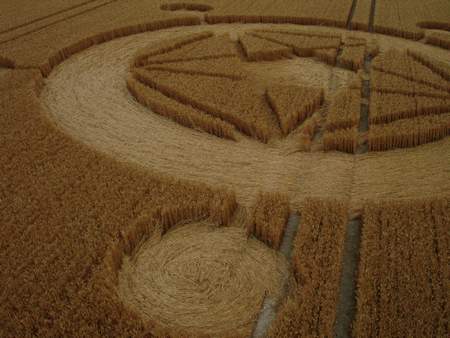
The laid pathways which make up the central part of the design vary in width, but are generally 2ft wide. The direction of the laid crop across the formation is clockwise, apart from the central pentagon where the flow is anti-clockwise. The outlying circles are connected to the main ring by short laid paths which flow out towards the perimeter. This flow continues under the clockwise These paths measure around 2ft wide and are around 6ft in length. The formation is aligned with one of the points of the pentagram, and one of the circles pointing directly north. 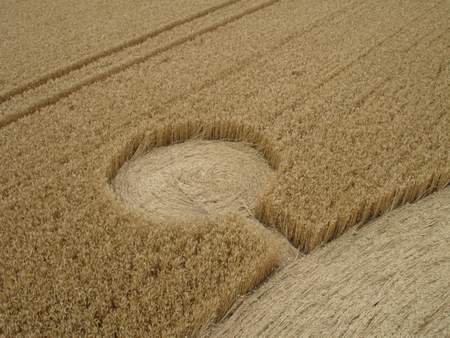
I am sure this formation has seen a few visitors as we were unable to visit until a day after its appearance, and the tramlines leading into the circle showed heavily crushed stems, more so than in other areas. 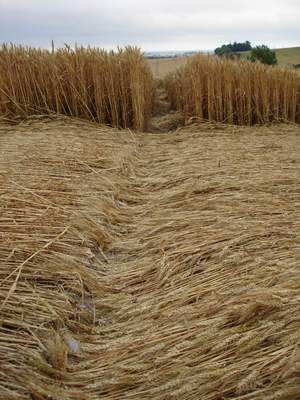
The condition of the laid crop was variable throughout the formation. On close inspection many of the stems showed evidence of kinking and crushing, and where the flow appeared to form a bridge over the tramlines, it was generally apparent that the crop had previously been squashed into them. Of course none of these observations are conclusive given that the formation had been visited before we surveyed it. The laid pathways which form the central pentagram and pentagon show some interesting features in the way they overlap each other. At some points the pathways flowing into the pentagon are laid over the top of the rest of the crop, while in other places they appear to have been laid first, meaning they flow into the pentagon underneath the rest of the crop. 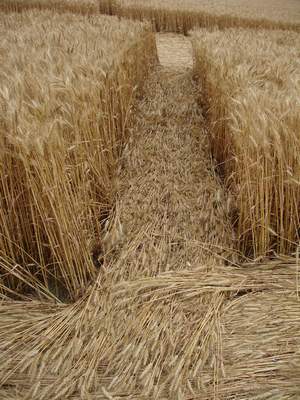
Sometimes the crop in the straight pathways continues through the edge of the central pentagon and out the other side, and in other places it tends to stop or follow the central pattern. I could not see any particular pattern or regularity to these differences. In some areas (see image below) some of the crop in the laid paths flows underneath that which it meets flowing in a different direction, while some of it appears to have been laid over the top! 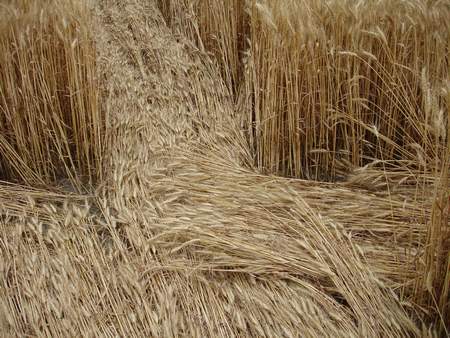
At one of the corners at the edge of the central area, where the pathways meet the encompassing ring, some of the crop flows neatly and quite sharply round the standing crop to join another path. The stems do not show any obvious sign of damage at this point. 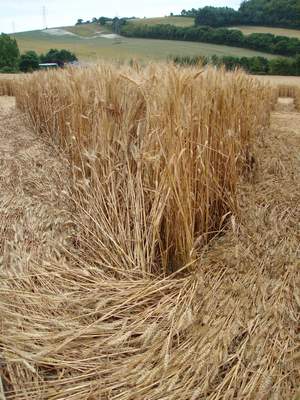
Another feature to the lay is that in some places the crop appears to change direction as it meets the tramline, proceeding to flow alongside it, parallel to the bare area and rather than over or into it. This could be down to simply the direction of the lay, but it is not something I have seen a lot of, although I did observe the same effect in the Milk Hill hexagons the previous day. 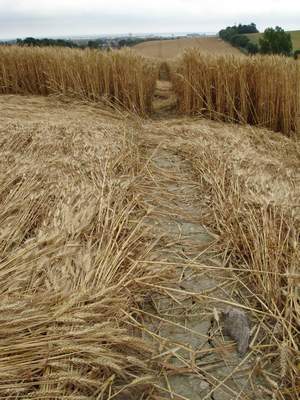
Unusual FindingsFirstly, in one of the tramlines was what appeared to be the wing of a pigeon, with no other remains of the bird around it (see above image). Admittedly it looked as though it had been there a little while and I am sure it was left by some predator, a fox presumably, but worth mentioning as it is not something I have discovered in a formation before. More difficult to explain and stranger still was to be found at the very centre of the formation. The crop is nicely swirled anti-clockwise and at the very centre where the crop there is a gap around 3 inches in diameter, where there is no crop. Looking into this gap, I noticed two dark objects (see image below). 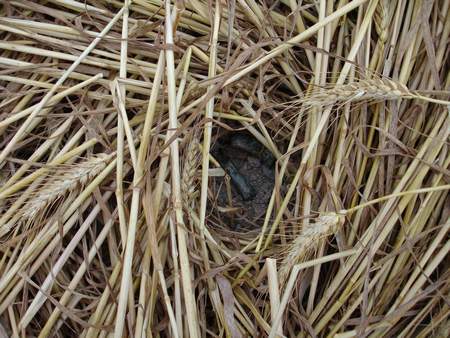
Closer inspection revealed that these were actually two mushroom stems, slightly decayed and dehydrated, which had either been ripped or burnt from their tops! There was nothing else in the gap. Now, I don’t know how common mushrooms are in the middle of crop fields, but I have never seen any myself. If they had been growing in the exact spot where the centre of the formation later appeared, the coincidence would be significant! And where are the mushroom heads? If they have been left there by someone, why? And why not eat the whole thing? Yet more unanswered questions!!! If anyone would like to analyse this suspicious fungus, I collected it, so please let me know. ‘Team Toadstool’ or a ‘genuine’ formation? I cannot tell, but this is a nice crop circle, in another lovely location, with many intriguing and thought provoking elements. I have really liked all three formations in Sussex so far this year, and this was a visit I thoroughly enjoyed and a formation I would like to have stayed in a lot longer, if only there were more hours in the day. 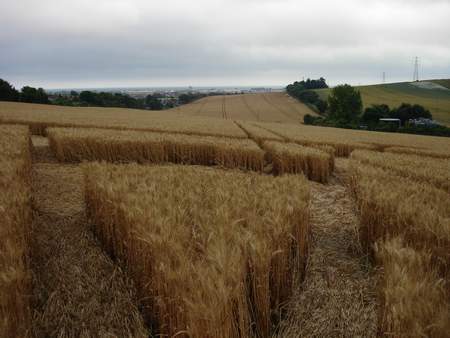
Crop Circle Summary
Alternative Websites |

